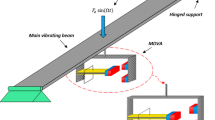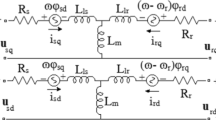Abstract
In this paper, Sommerfeld effect of a non-ideal induction motor in a simple cantilever beam system is studied. On basis of fully considering the interaction between the beam structure and the induction motor and its non-ideal characteristic, a continuous electromechanical coupling model of the typical non-ideal vibration system is developed and discretized by using the assumed mode method. Neglecting the fluctuation of the speed of the induction motor, the average speed at any power frequency is obtained and its stability is analyzed by using the perturbation method. The feasibility of the approach is validated by using some numerical simulations. The results indicate there appears the jump phenomenon, namely the Sommerfeld effect in the beam-motor system. The effects of the unbalance mass and power of induction motor on Sommerfeld effect are analyzed.















Similar content being viewed by others
References
Wang Z, Mak CM, Ou D (2017) Optimization of geometrical parameters for a supporting structure with two installed coherent machines. Appl Acoust 127:15–23. https://doi.org/10.1016/j.apacoust.2017.05.034
Balthazar JM, Mook DT, Weber HI, Brasil RMLRF, Fenili A, Belato D, Felix JLP (2003) An overview on non-ideal vibrations. Meccanica 38(6):613–621. https://doi.org/10.1023/a:1025877308510
Liu Y, Zhao Y, Li J, Lu H, Ma H (2019) Feature extraction method based on NOFRFs and its application in faulty rotor system with slight misalignment. Nonlinear Dynam 99(2):1763–1777. https://doi.org/10.1007/s11071-019-05340-8
Liu Y, Zhao YL, Li JT, Ma H, Yang Q, Yan XX (2020) Application of weighted contribution rate of nonlinear output frequency response functions to rotor rub-impact. Mech Syst Signal Pr 136:106518. https://doi.org/10.1016/j.ymssp.2019.106518
Shi H, Guo L, Tan S, Bai X (2019) Rolling bearing initial fault detection using long short-term memory recurrent network. IEEE Access 7:171559–171569. https://doi.org/10.1109/access.2019.2954091
Shi H, Bai X, Zhang K, Wu Y, Yue G (2019) Influence of uneven loading condition on the sound radiation of starved lubricated full ceramic ball bearings. J Sound Vib 461:114910. https://doi.org/10.1016/j.jsv.2019.114910
Samantaray AK, Dasgupta SS, Bhattacharyya R (2010) Sommerfeld effect in rotationally symmetric planar dynamical systems. Int J Eng Sci 48(1):21–36. https://doi.org/10.1016/j.ijengsci.2009.06.005
Goncalves PJP, Silveira M, Pontes Junior BR, Balthazar JM (2014) The dynamic behavior of a cantilever beam coupled to a non-ideal unbalanced motor through numerical and experimental analysis. J Sound Vib 333(20):5115–5129. https://doi.org/10.1016/j.jsv.2014.05.039
Sinha A, Bharti SK, Samantaray AK, Bhattacharyya R (2020) Sommerfeld effect in a single-DOF system with base excitation from motor driven mechanism. Mech Mach Theor 148:103808. https://doi.org/10.1016/j.mechmachtheory.2020.103808
Jha AK, Dasgupta SS (2020) Suppression of Sommerfeld effect in a non-ideal discrete rotor system with fractional order external damping. Eur J Mech A-Solid 79:103873. https://doi.org/10.1016/j.euromechsol.2019.103873
Jha AK, Dasgupta SS (2019) Attenuation of Sommerfeld effect in an internally damped eccentric shaft-disk system via active magnetic bearings. Meccanica 54(1–2):311–320. https://doi.org/10.1007/s11012-018-00936-7
Bharti SK, Bisoi A, Sinha A, Samantaray AK, Bhattacharyya R (2019) Sommerfeld effect at forward and backward critical speeds in a rigid rotor shaft system with anisotropic supports. J Sound Vib 442:330–349. https://doi.org/10.1016/j.jsv.2018.11.002
Bharti SK, Sinha A, Samantaray AK, Bhattacharyya R (2020) The Sommerfeld effect of second kind: passage through parametric instability in a rotor with non-circular shaft and anisotropic flexible supports. Nonlinear Dynam 100(4):3171–3197. https://doi.org/10.1007/s11071-020-05681-9
Varanis M, Balthazar JM, Silva A, Mereles AG, Pederiva R (2019) Remarks on the Sommerfeld effect characterization in the wavelet domain. J Vib Control 25(1):98–108. https://doi.org/10.1177/1077546318771804
Sinha A, Bharti SK, Samantaray AK, Chakraborty G, Bhattacharyya R (2018) Sommerfeld effect in an oscillator with a reciprocating mass. Nonlinear Dynam 93(3):1719–1739. https://doi.org/10.1007/s11071-018-4287-x
Bisoi A, Samantaray AK, Bhattacharyya R (2017) Sommerfeld effect in a gyroscopic overhung rotor-disk system. Nonlinear Dynam 88(3):1565–1585. https://doi.org/10.1007/s11071-017-3329-0
Rocha RT, Balthazar JM, Tusset AM, Quinn DD (2018) An analytical approximated solution and numerical simulations of a non-ideal system with saturation phenomenon. Nonlinear Dynam 94(1):429–442. https://doi.org/10.1007/s11071-018-4369-9
Palacios Felix JL, Balthazar JM, Rocha RT, Tusset AM, Janzen FC (2018) On vibration mitigation and energy harvesting of a non-ideal system with autoparametric vibration absorber system. Meccanica 53(13):3177–3188. https://doi.org/10.1007/s11012-018-0881-8
Cveticanin L, Zukovic M, Cveticanin D (2018) Oscillator with variable mass excited with non-ideal source. Nonlinear Dynam 92(2):673–682. https://doi.org/10.1007/s11071-018-4082-8
Werner U (2018) Vibration control of large induction motors using actuators between motor feet and steel frame foundation. Mech Syst Signal Pr 112:319–342. https://doi.org/10.1016/j.ymssp.2018.04.033
Werner U (2018) Vibration control of soft mounted induction motors with sleeve bearings using active motor foot mounts: a theoretical analysis. Arch Appl Mech 88(9):1657–1682. https://doi.org/10.1007/s00419-018-1393-7
Zhang X, Li C, Wang Z, Cui S (2018) Synchronous stability of four homodromy vibrators in a vibrating system with double resonant types. Shock Vib 2018:1–20. https://doi.org/10.1155/2018/9641231
Kong X, Jiang J, Zhou C, Xu Q, Chen C (2020) Sommerfeld effect and synchronization analysis in a simply supported beam system excited by two non-ideal induction motors. Nonlinear Dynam 100(3):2047–2070. https://doi.org/10.1007/s11071-020-05626-2
Umans SD (2014) Fitzgerald & Kingsley’s Electric Machinery. McGraw-Hill, United States
Li H, Niu Y, Li Z, Xu Z, Han Q (2020) Modeling of amplitude-dependent damping characteristics of fiber reinforced composite thin plate. Appl Math Model 80:394–407. https://doi.org/10.1016/j.apm.2019.11.048
Li H, Wu H, Zhang T, Wen B, Guan Z (2019) A nonlinear dynamic model of fiber-reinforced composite thin plate with temperature dependence in thermal environment. Compos Part B-Eng 162:206–218. https://doi.org/10.1016/j.compositesb.2018.10.070
Li H, Zhang T, Li Z, Wen B, Guan Z (2019) Modeling of the nonlinear dynamic degradation characteristics of fiber-reinforced composite thin plates in thermal environment. Nonlinear Dynam 98(1):819–839. https://doi.org/10.1007/s11071-019-05232-x
Li H, Lv H, Sun H, Qin Z, Xiong J, Han Q, Liu J, Wang X (2021) Nonlinear vibrations of fiber-reinforced composite cylindrical shells with bolt loosening boundary conditions. J Sound Vib. https://doi.org/10.1016/j.jsv.2021.115935
Wang G-X, Ding H, Chen L-Q (2020) Dynamic effect of internal resonance caused by gravity on the nonlinear vibration of vertical cantilever beams. J Sound Vib 474:115265. https://doi.org/10.1016/j.jsv.2020.115265
Acknowledgements
This work was supported by the National Natural Science Foundation of China [grant numbers 51705337, 51675350], the China Postdoctoral Science Foundation [grant numbers 2017M611258], the Natural Science Foundation of Liaoning Province [grant numbers 2019MS245, LJGD2020011 and 20180551036].
Author information
Authors and Affiliations
Corresponding author
Ethics declarations
Conflict of interest
The authors declare that they have no conflict of interest.
Additional information
Publisher's Note
Springer Nature remains neutral with regard to jurisdictional claims in published maps and institutional affiliations.
Appendix 1
Appendix 1
According to Eq. (10), the derivatives of w can be obtained as
Substituting Eqs. (A.1) -(A.3) into the first equation of Eq. (9), we can obtain
Multiplying both sides of Eq. (A.4) by \(\psi_{1} (x)\) and integrating them from 0 to L with respect to x, we can obtain
According to the orthogonality of the mode shape functions, we can obtain
Substituting Eqs. (A.6)–(A.7) into Eq. (A.5) and considering the characteristics of the Dirac delta function, we can obtain the first equations of Eq. (11) as
Similarly, multiplying both sides of Eq. (A.4) by \(\psi_{2} (x)\), \(\psi_{3} (x)\), …, \(\psi_{{\text{N}}} (x)\), respectively, and integrating them from 0 to L with respect to x, we can obtain
Finally, Eq. (11) is deduced.
Rights and permissions
About this article
Cite this article
Jiang, J., Kong, X., Chen, C. et al. Dynamic and stability analysis of a cantilever beam system excited by a non-ideal induction motor. Meccanica 56, 1675–1691 (2021). https://doi.org/10.1007/s11012-021-01333-3
Received:
Accepted:
Published:
Issue Date:
DOI: https://doi.org/10.1007/s11012-021-01333-3




